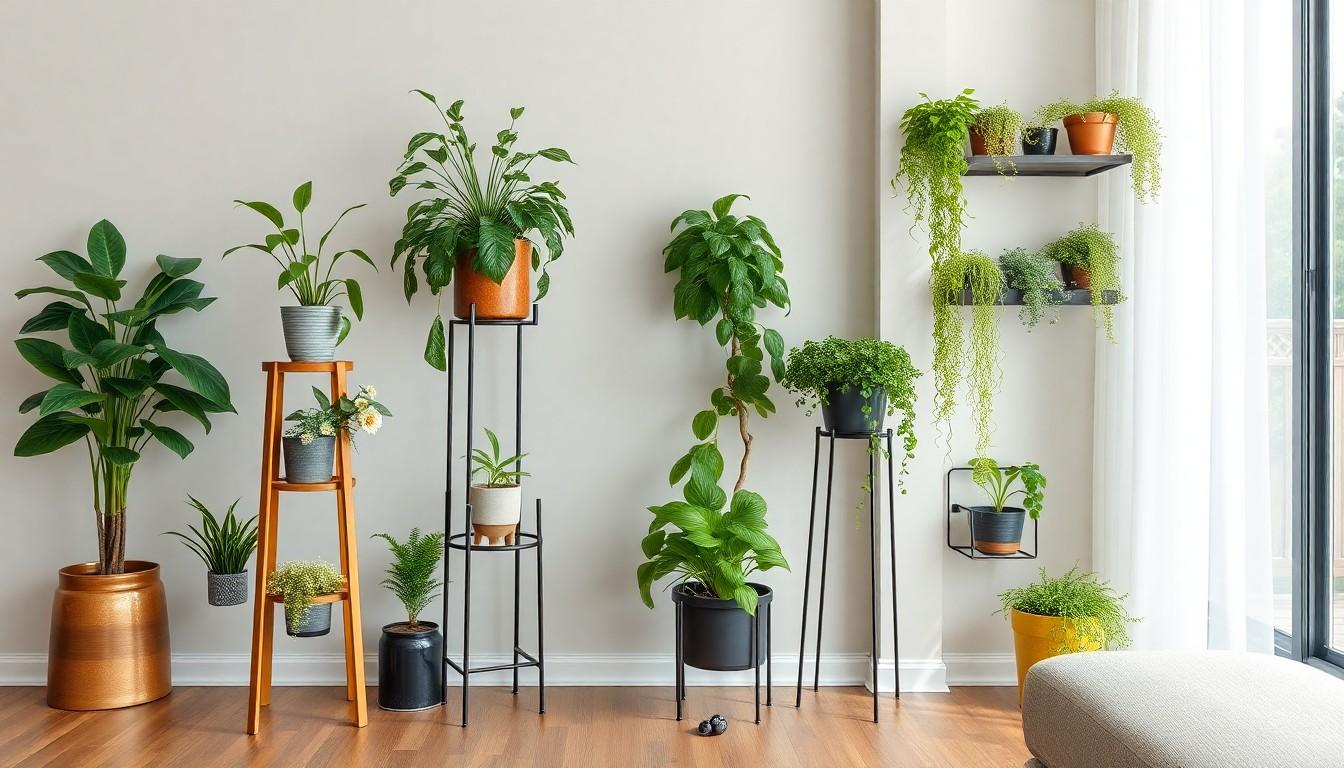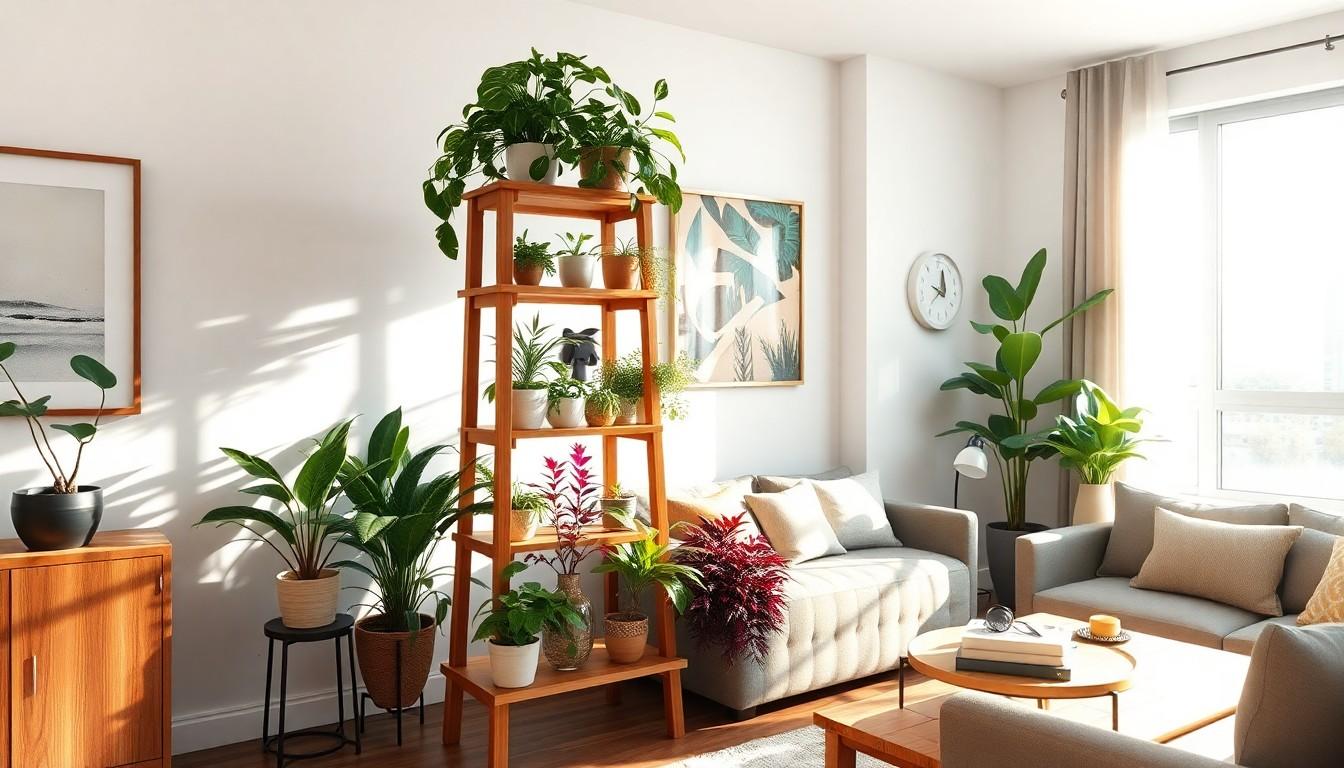Indoor plants are more than just a pretty face; they’re like little green companions that brighten up any space. But let’s be honest, they need a bit of elevation to truly shine. Enter the world of plant stands—those unsung heroes that not only boost your plants but also your home decor game. Who knew that giving your leafy friends a lift could transform your living room into a botanical paradise?
Overview of Plant Stands for Indoor Plants
Plant stands play a crucial role in indoor gardening. They elevate plants to eye level, making them more visually appealing. Different styles of plant stands accommodate various plant sizes and types. For instance, multi-tiered stands allow for a range of plants, from small succulents to larger ferns.
Many options exist when it comes to materials for plant stands. Wood, metal, and plastic provide durability and aesthetic flexibility. A wooden stand may evoke a rustic charm, while metal options can impart a modern touch.
Functionality also varies with design. Some stands offer storage capabilities for gardening supplies, while others simply provide display space. Ergonomics matter too—accessibility for watering and maintenance improves with the right height and design.
Colors and finishes can match or contrast existing home decor, enhancing overall aesthetic appeal. Neutral tones blend seamlessly into any space, while bold colors make a statement that stands out.
Consideration of the plant’s specific needs is essential when choosing a stand. Proper drainage is vital for many indoor plants, influencing the choice of materials and designs. Stands that include trays or pots help maintain moisture and prevent damage to floors.
When arranging plant stands, they can create visual interest and depth within a room. Placing taller stands in the back and shorter ones in the front forms a tiered effect. This layout ensures each plant receives adequate light while remaining easily visible.
Choosing the right plant stand elevates both the plants and the ambiance of the home. Numerous designs cater to diverse preferences, offering endless possibilities for personalization. With an array of options, every plant enthusiast can find the perfect stand to complement their indoor paradise.
Types of Plant Stands

Various types of plant stands cater to different needs and styles, enhancing the beauty of indoor plants. Understanding these options helps in selecting the best fit for any space.
Tiered Plant Stands
Tiered plant stands provide multiple levels for displaying plants. These stands allow for effective use of vertical space, showcasing a variety of plants in one compact area. With different heights, tiered stands enhance light distribution among plants, ensuring all receive adequate sunlight. They often create a visually appealing display with plants of varying sizes. Examples include multi-tiered wooden or metal structures that serve as focal points in a room.
Adjustable Plant Stands
Adjustable plant stands offer flexibility in height and configuration. Many feature telescoping legs or adjustable shelves, accommodating different plant sizes and types. Changing the height is beneficial for optimizing light exposure, especially for plants with specific light requirements. Customizable options allow for unique arrangements depending on the seasonal needs of the plants. This adaptability makes them ideal for both small and large spaces.
Wall-Mounted Plant Stands
Wall-mounted plant stands save valuable floor space while adding character to walls. These stands create vertical gardens, showcasing plants at eye level. They are often crafted from sturdy materials, ensuring stability for various plant weights. Wall-mounted stands can include shelves or pockets, suitable for herbs or trailing plants. Incorporating them into home decor adds a modern touch while enhancing the overall aesthetic of any room.
Benefits of Using Plant Stands
Using plant stands offers numerous advantages for indoor gardening enthusiasts. They provide better access to light, create visual interest, and enhance decor.
Space Optimization
Plant stands maximize available space in homes. Vertical arrangements allow more plants to fit in a smaller footprint. Stands can transform corners or underutilized areas into vibrant plant displays. Multiple tiered options make it easy to showcase various plant sizes while maintaining accessibility. Apartments or homes with limited floor space benefit significantly from wall-mounted stands, which free up valuable ground area. Each design contributes to a more organized, aesthetically pleasing environment, allowing plants to thrive without overcrowding.
Aesthetic Appeal
Enhancing visual appeal is another significant benefit of plant stands. Different styles and materials complement various decor themes, from modern to rustic. Plant stands make plants more visible, drawing attention to their beauty and unique characteristics. Creatively arranging stands can introduce layers, depth, and texture to indoor spaces. Elevated plants create a lush, inviting atmosphere that can uplift any room’s vibe. Additionally, incorporating colorful or stylish stands can serve as conversational pieces, adding a personal touch to home decor.
How to Choose the Right Plant Stand
Choosing the right plant stand involves considering several factors to ensure it complements both the plants and the living space.
Consider Your Plant Size
Plant size significantly influences the type of stand suitable for specific plants. Taller plants require stands that provide adequate height for optimal light exposure, while smaller plants benefit from compact stands. The weight of the plant also matters; heavier plants need sturdy stands to provide necessary support. Additionally, ensuring that the pot size fits the stand is crucial to prevent tipping. Evaluating these aspects helps in selecting the perfect stand for diverse plant types.
Material and Design Preferences
Material and design play vital roles in selecting a suitable plant stand. Wooden stands bring warmth and character, fitting well with rustic and traditional themes. Metal options offer a sleek, modern look that complements contemporary decor. Plastic stands are lightweight and versatile, making them ideal for dynamic arrangements. Personal preferences should guide the choice of materials to align with existing decor styles. Considering color, shape, and texture adds a unique touch, enhancing the overall aesthetic appeal in any indoor space.
Care and Maintenance Tips
To maintain the beauty of indoor plants on their stands, regular watering is essential. Adjustments in watering frequency depend on the plant species and environmental conditions. Observe the soil moisture level; if the top inch feels dry, it’s time to water.
Ensuring adequate light is another crucial factor. Position plant stands where plants receive optimal light without direct harsh sun, which can scorch leaves. Rotate plants periodically to promote even growth on all sides.
Cleaning plant stands and plant leaves contributes significantly to the overall aesthetic. Dusting stands helps maintain their appearance while wiping leaves encourages photosynthesis. Use a damp cloth to gently clean leaves, removing any accumulated dust or dirt.
Proper drainage is vital for plant health. Confirm that pots fit well in their stands and that drainage holes are unobstructed. Consider adding saucers under pots to catch excess water, preventing damage to the stand.
Fertilizing plants at the right intervals enhances their growth. Depending on plant type, use a balanced, water-soluble fertilizer every 4-6 weeks during the growing season. Follow label instructions for dilution rates for optimal results.
Monitoring for pests is essential in maintaining indoor plants. Check regularly for signs of infestation, such as discolored leaves or webbing. If pests are present, treat them promptly using insecticidal soap or neem oil.
Adjusting the location of plant stands during seasonal changes supports plant wellness. Move plants closer to light sources in winter while ensuring they don’t become too hot near heat sources. Each adjustment contributes to maintaining a vibrant indoor garden.
Conclusion
Selecting the right plant stand can significantly enhance the beauty and health of indoor plants. With various styles and materials available, plant enthusiasts can find options that align with their decor and functional needs. Proper arrangement and height considerations not only improve light access but also add depth and visual interest to living spaces.
Regular care and maintenance ensure that both plants and stands remain in top condition. By thoughtfully choosing and arranging plant stands, anyone can create a stunning indoor garden that reflects personal style while promoting plant wellness. Embracing these elements turns any room into a vibrant oasis.

